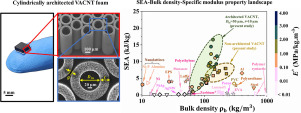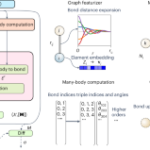2022-11-18 ウィスコンシン大学マディソン校(UWMadison)

・ UW-Madison が、ヘルメットの保護機能を飛躍的に向上させる、軽量で高い衝撃吸収性を備えたカーボンナノチューブ(CNTs)ベースの発泡材料を開発。
・ 米軍の戦闘用ヘルメットのライナーに使用されている発泡材料の 18 倍の比エネルギー吸収能力に加え、より高い強度や硬度を提供。衝撃による運動エネルギーの吸収・拡散に優れた新材料を使用したヘルメットでは、脳への外傷や脳しんとう等の緩和や回避が期待できる。
・ 新発泡材料は、原子 1 個の薄さの筒状炭素分子である CNTs を構成要素とし、長さがそれぞれ異なる CNTs の縦方向整列構造により、優れた機械特性をもつ CNTs の性能をさらに向上させた。
・ 発泡体の最適化を最大化する CNTs の薄さ、内径や間隙等の設計パラメータを特定するため、60種類の組合せの各サンプルにつき 3 種類の合計 180 件の実験を実施。
・ その結果、筒形状が 10 ㎛以下の薄さと、最小の間隙による構造が最も優れた衝撃吸収能力の発泡体を構築することを確認。これは、プロセス、構造、特性の相関性に起因した異例の寸法効果によるもの。
・ さらに、CNTs による構成要素により非常に高い温度・低い温度下でも優れた衝撃吸収能力を保持することも確認。様々な過酷な環境下でのアプリケーションの可能性を示す。
・ 本研究は、ヘルメットメーカーの Team Wendy と共同で実施。ヘルメットライナーのプロトタイプとしての実際のアプリケーションでの新材料の性能を評価した。この産学連携は、UW-Madison の率いるPANTHER プログラム(外傷性脳損傷の発見と回避の向上の解決策を開発する学際的な研究イニシアティブ)の一環。
・ 本研究の資金は、PANTHER プログラム下、米国海軍研究室(ONR)および米国陸軍研究局(ARO)が提供した。
URL: https://news.wisc.edu/new-carbon-nanotube-based-foam-promises-superior-protection-against-concussions/
<NEDO海外技術情報より>
関連情報
Extreme Mechanics Letters 掲載論文(アブストラクトのみ:全文は有料)
Superior mechanical properties by exploiting size-effects and multiscale interactions in hierarchically
architected foams
URL: https://www.sciencedirect.com/science/article/abs/pii/S2352431622001754?dgcid=author
Abstract
Protective applications in extreme environments demand materials with superior modulus, strength, and specific energy absorption (SEA) at lightweight. They must also have the ability to attenuate intense stress waves and absorb kinetic energy from impact while providing thermally stable functionality. However, these properties typically have a trade-off. Hierarchically architected materials—such as the architected vertically aligned carbon nanotube (VACNT) foams—offer the potential to overcome these trade-offs and achieve synergistic enhancement in mechanical properties because of their multiscale origins of bulk properties derived from structural features that span nano to millimeter scales. Such architected materials with complex hierarchical structures require careful investigation of the effects of multitier design parameters and their interactions on the resultant bulk mechanical properties. Here, we adopt a full-factorial design of experiments (DOE) approach to identify an optimal set of design parameters to achieve synergistic enhancement in SEA, compressive strength, and modulus at lightweight in VACNT foams with mesoscale cylindrical architecture. We exploit size effects from geometrically-confined synthesis and highly interactive morphology of the CNTs to enable higher-order design parameter interactions that intriguingly disrupt the diameter-to-thickness (D/t)-dependent scaling laws found in common architected materials having steel and composite tubular structures. We show that exploiting complementary hierarchical mechanisms in architected material design can lead to superior and synergistic enhancement of mechanical properties and performance desirable for extreme protective applications.




